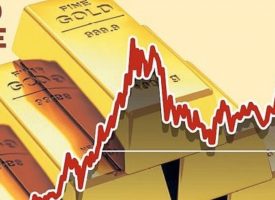With the Dow falling over 250 points and crude oil continuing to struggle, today two of the greats in the business sent King World News powerful pieces exposing what is about to accelerate the invisible collapse.
First, a powerful warning from Art Cashin and friends – Unintended Consequences? – My old friend, Ron Insana, voiced some concerns about the potential for surprise in some of the mechanics that accompanied “liftoff”. Here’s some of what he wrote in a piece at CNBC.com:

First, not mentioned in the statement is the fact that, in addition to raising its target for the federal-funds rate, the central bank is raising the discount rate a quarter point to 1 percent. That is to be expected. However, the Fed is also raising the rate it pays
member banks to hold required reserves at the Fed, doubling that payment
to a half-point. This gives banks a much bigger incentive to earn a
half-point on their cash, risk free!
That is a major disincentive for banks to make further loans. And it comes at a time when the velocity of money, or the speed with which the
money supply turns over, is close to zero.
I will add in a potential paradox I have cited for many months now. The Fed Funds target rate is now 0.25% to 0.50%. The median is 0.375%. Fed Funds are when one bank borrows excess free reserves from another bank. But, if the second bank is already getting 0.50% risk free from the Fed, why would they ever lend to another bank at the same rate?
Let’s see what happens when the gears began to turn.
The Market Thinks Any Future Move Will Be Even Slower Than Fed Says – Traders and the markets were a bit dismissive of the Fed’s “Dot Plot” or projections of potential future rate moves. The difference is nicely summed up in a Bloomberg column tilted: “The Market Isn’t Convinced”. Here’s what it said:

For all its clarity and predictability, the Federal Reserve’s decision to raise short-term interest rates hasn’t resolved a major point of disagreement between the central bank and markets: the path of future rate increases.
In projections that accompanied Wednesday’s monetary policy decision, Fed officials expressed confidence that a growing economy will justify a significant increase in rates during the coming year. Their median forecast for the central-bank’s short-term target at the end of 2016 was 1.375 percent. By some measures, that level could actually be above neutral, meaning the Fed would be hitting the economic brakes.
Markets, by contrast, appear less sanguine. As of Wednesday afternoon, prices of fed funds futures contracts, which traders use to bet on the path of interest rates, implied a target rate of only 0.835 percent in December 2016. Combined with relatively low expectations for inflation, this indicates that the market thinks the economy will be weaker than the Fed predicts — or that the central bank will revise its view of the rate consistent with stable growth and inflation.
….. the Fed and the market are slightly more in agreement than they were in September, the last time the central bank published official forecasts. Both have lowered their projections during the past couple years, though the futures market reversed course a bit in recent months — probably reflecting the growing realization that the Fed would finally initiate liftoff this month.
Still, the persistent gap means that either the Fed will have to change its forecasts further or the market will be proven wrong. In the latter case, expect more volatility.
My friend, Peter Boockvar, the chief market analyst at the Lindsey Group noted that disparity between the Fed and the market in a brief note to some friends:
There remains a large difference of opinion over where the fed funds rate will be by the end of 2016. The Fed dot’s have it at an average level of 1.375%, implying 4 hikes next year. This compares with the December fed funds futures contract which is currently priced at .825% and which is only an increase of another 45 bps above the current .375 bps (now the new middle of the range).
Consensus – Earlier in the week we said that it might take days not hours to see the real reaction to the Fed move. My best guess, it may take till Tuesday or Wednesday due to Friday’s massive expiration. Watch oil and stay wary, alert and very, very nimble.
Included below are four questions and answers from today’s Q&A with Bill Fleckenstein.
Bonus Q&A
Question: Bill, after the ramp yesterday, are you adding any puts into today’s weakness? Thanks
Answer from Fleck: “No, I’m still sitting with a small group of shorts and a few puts. My exposure is pretty low, but that may change if the market starts to really break.”
Question: This seems to be one of those times when the sentiment towards an asset, in this case PM, has gone down so far that nothing will revive it, which is of course the dream of the Fed and the banks. It has become more and more depressing. Manipulation clearly has to be extant. The Fed clearly has lots of fans!! The rate hike yesterday gets a huge bid in the markets!! Employment is not cratering, it seems. Etc. Bill, wikll we believers in honest money ever be “right” again?
Answer from Fleck: “Isn’t that sort of sentiment exactly what everyone always thinks they want to see to buy into? It just turns out to be harder emotionally than what most people can stand. The Fed and the banks don’t care about gold. The problem is no one else seems to either, still, but that will change.”
Question: You have explained how QE has lead to the collapse in oil prices. In your opinion, would the reverse also hold true? I.e. if rates were to rise and this lead to the significant defaults in fracking companies, this would lead to consolidation of the industry by the big players and eventually they will restrict supply to produce profitably. Thus, would a collapse in the fracking junk bond market potentially be one of the signals of a bottom in oil prices?
Answer from Fleck: “It is a prerequisite I would say, but just seeing the debt of frackers collapse probably isn’t enough.”
Question: Bill, does the “Lord of the Dark Matter” think the Fed’s “Plumbing” can handle the rate hike? For background:
Fed Reveals Rate Hike “Plumbing” Details: Removes Cap On Reverse Repos, Limits Each Counterparty To $30 Billion
Thanks!
Answer from Fleck: “He hasn’t had any new comments in a few days, but he was suspect as to whether they did in fact have the right tools. That remains to be seen. No way you know for sure until we see what starts to happen.”
***Michael Pento’s remarkable KWN audio interview has now been released and you can listen to it by CLICKING HERE OR ON THE IMAGE BELOW.
***ALSO JUST RELEASED: 3 Stunning 40+ Year Charts Expose How Fed Rate Hike Will Impact Gold, Bonds And Commodities CLICK HERE.
© 2015 by King World News®. All Rights Reserved. This material may not be published, broadcast, rewritten, or redistributed. However, linking directly to the articles is permitted and encouraged.









